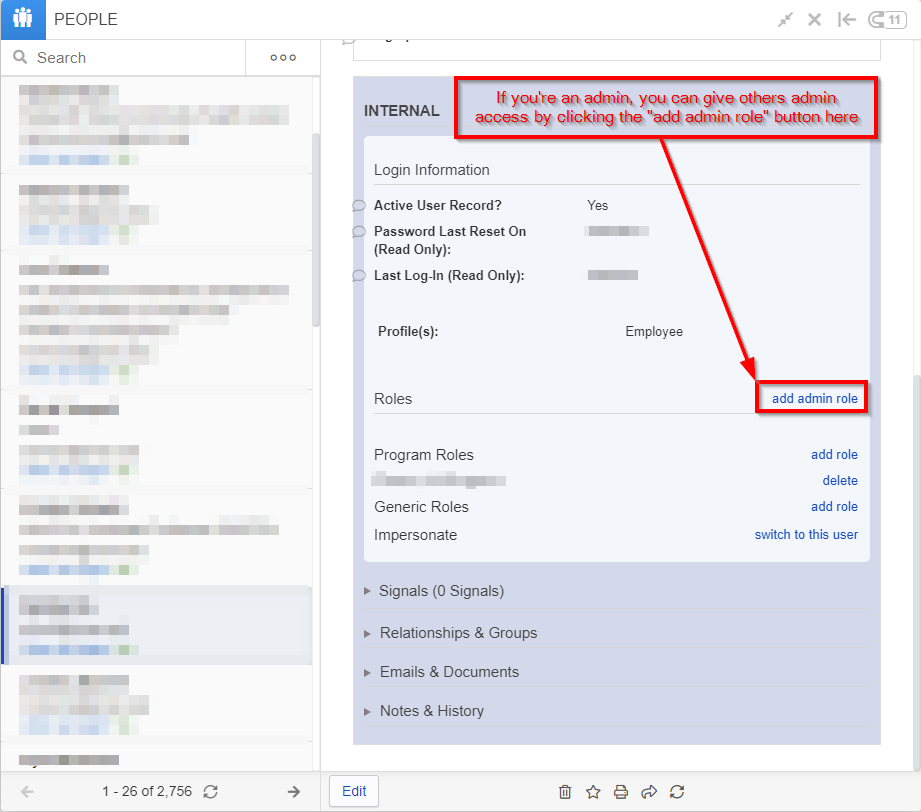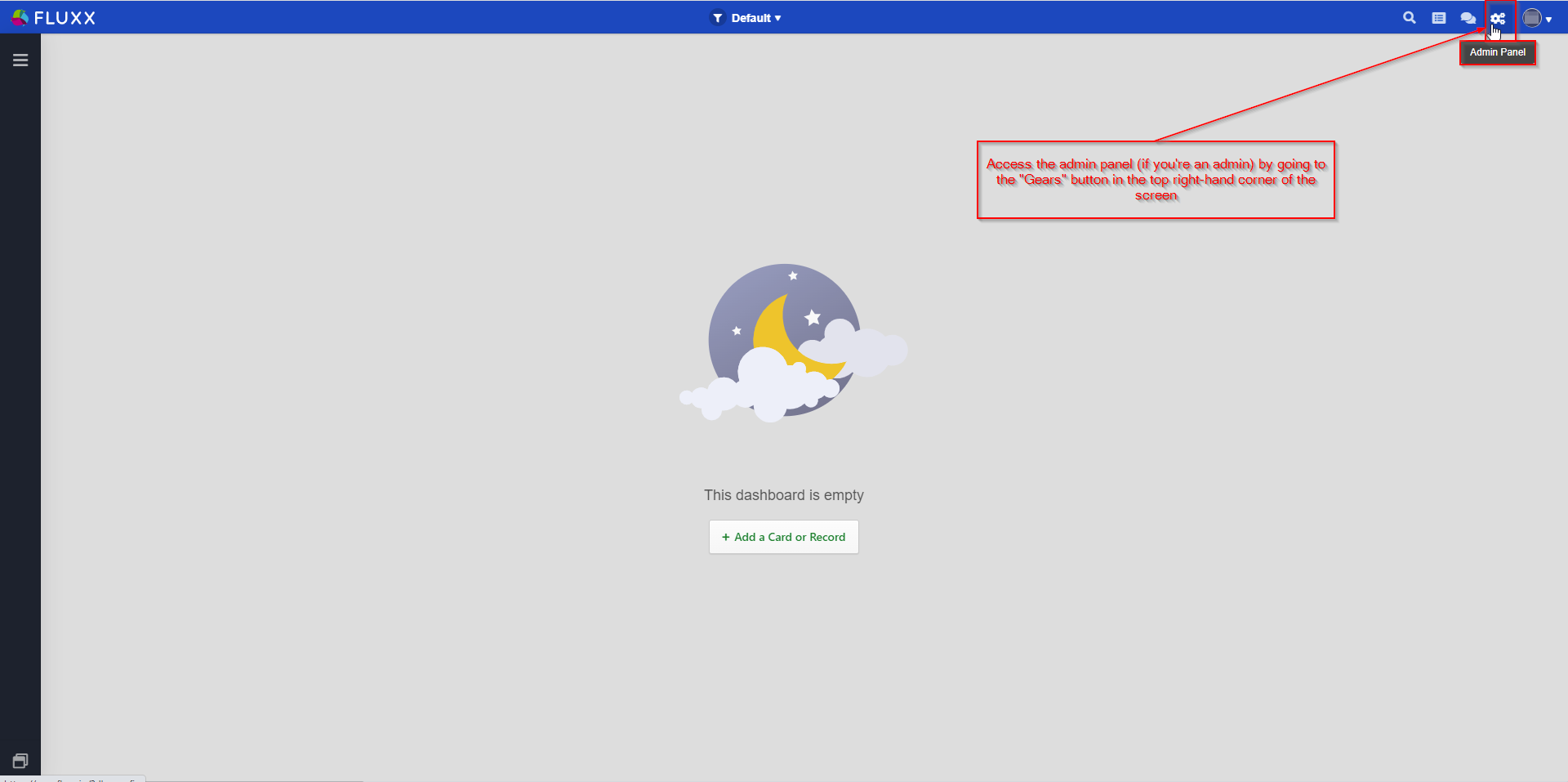Admin Privileges
In Fluxx, the Admin Panel is the place to edit/change almost all background settings and the look, feel, and fields of Forms and documents found throughout the system.
In order to access the Admin Panel, your user account must have Admin Privileges.
If a new user needs Admin Privileges, a user who is already an admin will need to give them the "Admin" role. As an admin, you can do so by navigating to the user's record, scrolling down to the "Internal" section, and clicking the "add admin role" button found there within (see also the screenshot below).
Once the user is listed as an admin, they might need to refresh their browser for the change to take effect. Once it does, the user will be able to see the "Gears" icon needed to access the Admin Panel (see the next section for more information on this).
Accessing the Admin Panel
If you're user account has Admin Privileges (see the section above for more information on this), you'll be able to see a "Gears" icon in the top right-hand corner of your screen from any dashboard you are on (see also the screenshot below). If you do have Admin Privileges, you can just click on the Gears icon to be brought into the Admin Panel.
Note: Fluxx best practices recommend CTRL + Clicking on the Admin Panel gears (or right-clicking and selecting "Open Link in New Tab"); the reason for this is that it will allow you to see both the Front End (via the dashboard that you clicked on the Gears from) AND the backend form data from the Admin Panel in the second tab.
Into the Admin Panel
Once you click the "Gears" button, you'll be brought into the Admin Panel, which should look somewhat like the screenshot, below. See below for descriptions of the boxed items in the screenshot.
- Box # 1: Shows the Main Menu Grouping, the highest level of grouping within the Admin Panel. Underneath the first four of these Main Menus (Forms, Workflow, Card Settings, and Card Documents), you'll find Submenus (see box # 2 for an example of this) that allow you to edit/change records in different record types, i.e. change the form for a Grant Application vs. Change the form for a Requirement. Description for each of the Main Menu Groupings:
- Forms – This is the most used of the Main Menus. Forms dictate how applications, requirements, organization, user, etc. records appear, what fields they contain, and dictate required formatting for said fields. This is where you create new applications or edit existing ones.
- Workflows – Probably the third most used Main Menu. Dictates how the Workflow should flow for each "Theme" of every Data Type. This is where you can edit how a workflow functions and where you'll add new workflows to newly-created forms. NOTE: EVERY form that uses workflows (I.e. Grant Applications, Requirements, Registrations, Reviews, and Amendments) MUST have a workflow assigned to it, otherwise grantees will be unable to submit these forms to the Partnership Program.
- Card Settings – Holds settings for the Export Format (how cards get exported when clicked "Excel Export"), as well as the list of Fields for each data type (allowing you to edit certain fields after they've been created, e.g. converting a Single Select field into a Multi-Select field).
- Card Documents – Main Menu for creating new file upload types or editing existing ones (Document Types), creating "Letters," and finally for editing or creating Email Notifications for Grantees, Reviewers, and WPP Staff.
- User Settings – Stores setting for the different User Profile and User Role options. This is where you can create a new portal or a new User Role if the need presents itself. Additionally, this Menu contains other Security Settings, like the minimum password length for a User or giving extra permissions to specific profile (e.g. allowing Employees without Admin access to Impersonate Grantees).
- Programs – Allows you to edit/add Programs (the Fluxx quasi-equivalent of WPP's Fund) and Subprograms (the Fluxx quasi-equivalent of WPP's Subfund). Since this can also be done from a normal dashboard and does NOT have to be done from within the Admin Panel, this menu is one of the least used.
- Queue – Contains both the Jobs Queue (which shows you the status of Exports, Report Runs, and Bulk Updates) and the Email Queue (which shows you emails that have been queued to send but that have not yet actually been sent). Since the WPP has a number of email notifications set to Queue rather than send directly, the latter queue is much more relevant and should be regularly monitored to ensure that important emails don't remain stuck in the queue.
- Cache – Shows high-level statistics on our instance of Fluxx. Likely the least used of all the Main Menus. No submenus can be found underneath Cache.
- Migrations – Shows Migrations that have previously been performed in the system as well as allows you to create new configurations in order to Migrate or Import other data into the system. Essentially, this Menu allows you to put together an Excel or CSV file with data to tie back to records within the system and load it so that those data get added to the records in question.
- Data Management – Shows you potential duplicates spotted by the system. Does NOT allow you to Merge those duplicates from here, however.
- Plug Ins – Contains a number of settings for Integration with Fluxx. This is where, for example, you can set up the connection to DocuSign, Google Analytics, Outlook Integration, etc. It also allows you to edit the links and the wording on the WPP Fluxx Homepage (i.e. the links to the OAC and PERC Registration Forms).
- Finance – Not really used for WPP. Allows admins to change Bank Account information on file (not used by WPP), update Funding Sources (which can also be done from a normal dashboard, which is preferable), and change some Finance Settings not used by the WPP.
- Global Settings – Contains a smorgasbord of other settings not found elsewhere. A few examples of settings stored here: Fiscal Year Settings, Grant ID settings, Session Timeout Settings, Settings to change the names of all cards in the system, etc.
- Box # 2: Shows the Submenus available for the Main Menu selected (in this example: Forms). The submenu "Grant Request" is selected, and the already-built Themes (different application form types) are seen underneath the submenu title. If you want to edit/preview a specific theme, simply click on its name from this list to select it.
- Additionally, you can find buttons like "New Theme" at the bottom of this list before "Retired Themes" and "Filter." This allows you to create a new application form either from scratch or by copying another form first.
- Box # 3: Displays the Preview of the Theme currently selected. In the example screenshot, you can see a Preview of the "2022 COVID-19 Response Application" (the currently selected Theme).
- From the Forms menu, there's also the "Builder" button here; if you click this, you will be brought to the screen where you can actually edit the Theme rather than simply previewing it.


